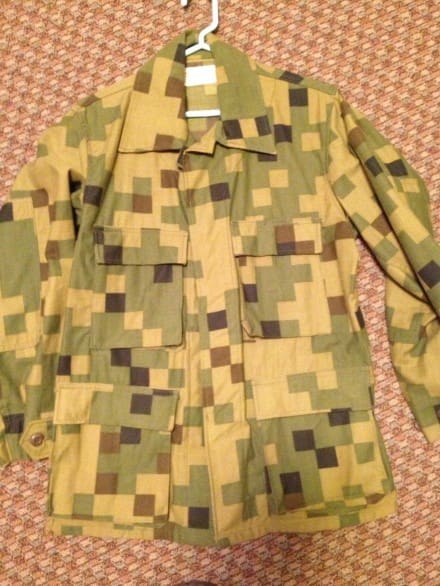One of our readers shared this photo of a BDU jacket purchased in the mid-90s at a surplus store. The so-called Dual-Tex pattern was developed by Dr Tim O’Neill (LTC, USA ret) and was tested on uniforms as well as armored vehicles at the 2nd ACR in 1977-78 for urban warfare use. It was not adopted.
Thanks to Vince for sharing!



At least in terms of the macropattern, I think this stuff is arguably superior to a lot of the digital camouflage out there nowadays…
Ouch!
This requires some explanation. The uniform was put together by Natick Labs by request from TRADOC — this design was Natick’s interpretation, not mine. I think they made a few uniforms as a sample, then happily forgot about it.
I don’t usually enter these discussions, but it’s important to understand that “digital” camouflage isn’t just little squares — that’s a myth that developed after the look and feel went fashionable while the science and design guidelines went unread (I admit, it’s dull reading about visual biophysics). The result was a lot of “digital” designs that fell short because nobody read the instructions . . .
Some existing “digital” designs — I prefer “texture match” — were done right and perform very well. The Marine Corps designs are a good example. If you design it right, it works very well in testing and in the field; if you don’t, it is less impressive.
Tim O’Neill,
US Army (R)
That looks like 8-bit camo . . . .
It’s pretty good size isn’t it?
SSD everyone knows that’s a nice way of saying it’s small!
I actually find this more appealing than a lot of camos I have seen recently, sad but true.
Yup, back when pixels were HUGE!
Pong-flage!
J OPT “PONG-FLAGE!” HAHAHAH FTW!
If I remember correctly, that camo was featured in this book:
http://www.amazon.com/Camouflage-Uniforms-European-NATO-Armies/dp/0764310186/ref=sr_1_1?ie=UTF8&qid=1355192013&sr=8-1&keywords=NATO+camouflage+uniforms
I can’t remember the exact date when it was made / used / issued but it was sometime in the mid-80’s I believe, and it was around about the same time as the experimental USMC “Urban-T” pattern.
The Dual Tex vehicle trials were in the late 70s but I think the uniform was probably early 80s. My reasoning is the uniform cut. The BDU cut changed in 1985 and this style was officially adopted in 1981.
That makes sense. Its too bad that my copy of that book is buried away in storage boxes somewhere, and that your friend didn’t send a close-up of the label.
He sent a size label but not a contract / description label.
Would the pixel camouflage patterns on some ADF vehicles be perhaps related to the development of modern day camouflage?
I’ve always seen the patterns on Land Rovers and Unimogs and wondered what the story with those were.
https://farm4.staticflickr.com/3604/3684399728_c06d117a53.jpg
https://farm3.static.flickr.com/2795/4247750849_b5a3492eb3.jpg
Not pixels per se, but the hexagon-like pattern is certainly interesting.
I know the Philippine presidential security group (PSG) have been wearing this pixelated pattern since the late 1990s. This kinda reminds me of that!
aka the Berlin Camo
Looks like a Creeper from Minecraft:
http://images.wikia.com/minecraft/images/9/93/Creepers_yay.png
🙂
Are the bottomes bell bottomed?
(sp) bottoms
still better than ACU camo…
If you didn’t say it, I would have.
Interesting to see how camouflage evolves over time. And yet some things never change.
Looks about the size of the current Latvian camo in AFG.
http://www.rigasummit.lv/en/id/cats/nid/797/
Singapore had a very small pixel pattern.
http://toyhaven.blogspot.com/2009_06_01_archive.html
We used to joke that Asia always got the better resolution stuff 1st.
When I was in the 2nd ACR in the late 80,s that was the paint pattern on our M60A3 tanks, ours was the only unit with that pattern.
The use in the 2nd ACR was because one of the officers on the West Point faculty who helped in the testing in 1977 rotated to the 2ACR and demonstrated the method.
The Dual-Tex design performed very well, but was beyond the state of the art at the time.
Tim O’Neill